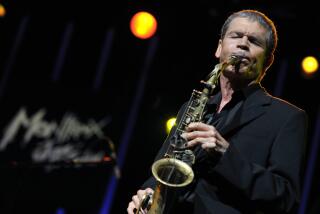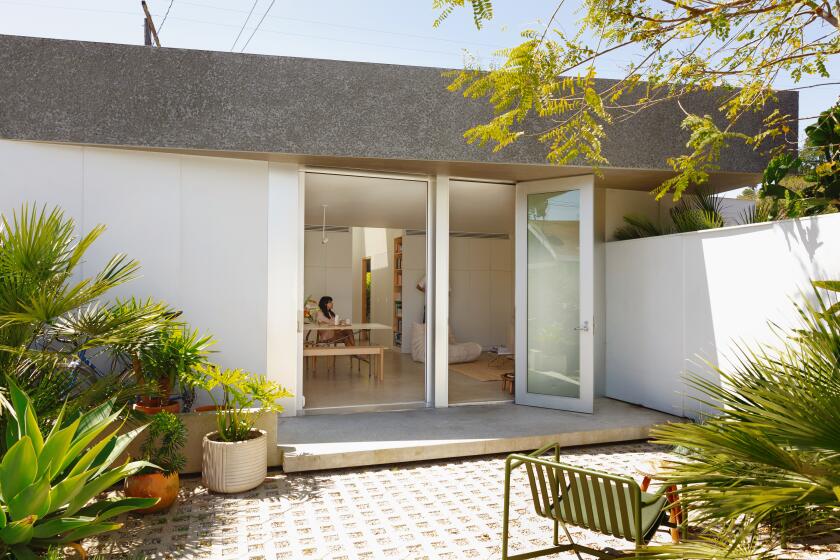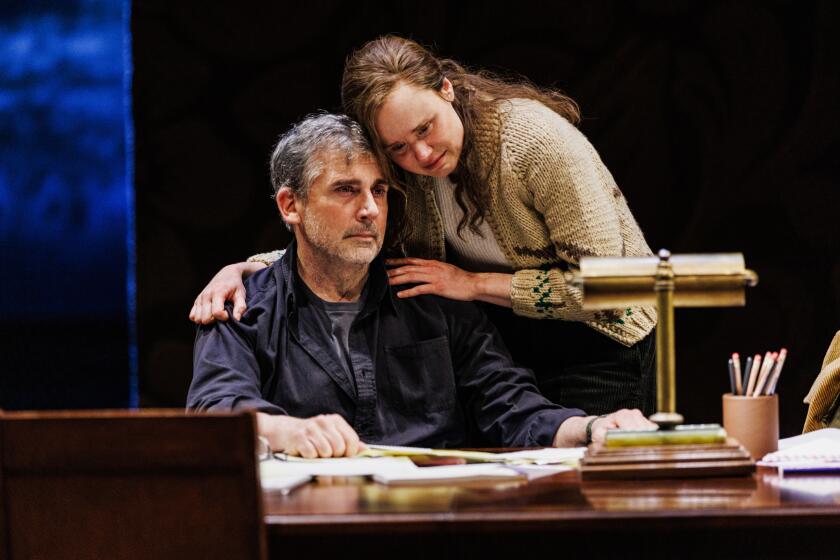Seven million visits later ...
Five and a half years ago, when dust was still rising at the Getty Center and all the world was speculating about what, exactly, the $1.3-billion castle on a hill would be, the Getty’s No. 1 art guy made an astonishing statement. “We have gained respect for visitors who don’t come to a museum with the idea they are visiting a school or library, but as if they are going to a park,” said John Walsh, a scholar of Dutch painting who directed the J. Paul Getty Museum from 1983 to 2000.
As the opening drew closer, artist Robert Irwin expressed similar thoughts about the 134,000-square-foot Central Garden he designed for the Getty Center: “My hope is that people will recognize that this is a sculptural environment, but that they’ll also find it inviting enough that they’ll flop down on the grass because this is a garden to be used.”
The Getty Center -- which houses the J. Paul Getty Trust’s offices and programs, including a museum, institutes for art conservation and research and a grant program, on a 24-acre campus carved out of a 750-acre property in Brentwood -- will celebrate its fifth anniversary on Monday. And if anything is clear at a glance, at least on sunny weekends, it’s that the Getty is used in exactly the ways Walsh and Irwin envisioned. If you build it, they will come, look, eat, walk and plop down.
That wasn’t obvious from the get-go. Even as the Getty Center opened its doors to throngs of arts professionals and the public, some observers complained that its lofty site in a ritzy neighborhood exacerbated its elitist image. Commenting in a Christian Scientist Monitor article published on opening day, author Mike Davis likened the center to “a remote spaceship that dropped into the Santa Monica mountains” and warned that “the locals are still waiting to see if it’s friendly.”
It seems that many have. On the day after Thanksgiving, one of the busiest days of the year, more than 8,700 people visit the center. Young couples who want to be alone hike up to the museum instead of taking the tram. Families eat brown-bag lunches at outdoor tables or treat themselves to salads, pizzas and sandwiches in the cafeteria.
Local visitors make beelines to their favorite vantage spots and point out distant sights to their guests from Cincinnati, Toronto and Omaha. Little boys stick their fingers in fountains and waterways as their parents herd them along. Children roll down the hill at the top of the garden, squealing in delight.
It’s a scene of human dramas and life lessons. An elderly man, walking with a cane and wheeling an oxygen tank, pauses to get his bearings at a scale model of the center, displayed on the museum’s plaza, then soldiers on with his slightly younger mate. A young father teaches his tiny daughter how to climb the stairs to the temporary exhibitions gallery: “First one foot and then the other.”
On days like this it may appear that people go to the Getty to do anything but look at art. But no, every gallery is crowded, and for each person who strolls through, there’s someone engaged with an artwork.
Some work on assignments. In a display of ancient Greek and Roman sculpture, Montebello High School students fill out a questionnaire on a marble statue of Marcus Aurelius, on loan from Berlin’s Pergamon Museum.
Nearby, Liz Cvitan, a student from Mount St. Mary’s High School, prepares a report on a Roman statue of Venus, but she often comes on her own or with her mother, artist Kirsten Cvitan. “I used to go to the old Getty Museum, but now that it’s closed for renovation I come here,” Liz says. “It’s a lot of fun to get to know the art.”
Upstairs, art education transpires more informally. A man sprawled on a couch with his son gazes at Nicolas Poussin’s 1651 painting “Landscape With a Calm” and explains that the French artist was an ace at differentiating clouds from mountains while using the same blue-gray palette. In another gallery, a young man stares at “Bust of a Noblewoman,” a sculpture made by Guiliano Finelli in 1630, and asks his date, “What makes her noble? Money?”
The gallery that always draws the largest crowd displays the museum’s collection of French Impressionist and Post-Impressionist pictures. Today is no different, but Dutch artist Gerrit von Honthorst’s 1622 painting “A Musical Group on a Balcony,” installed on the ceiling of a small passageway, is a bigger hit with kids. Adults, who tend to look ahead, not up, usually miss it. But youngsters spot the figures on the ceiling, proclaim the artwork “cool” and walk in circles, heads thrown back.
“No matter where you go, that guy in the red-feathered hat is looking at you,” Jason Matthews, 10, tells his friend.
So it goes at the museum, where every information center is packed with people looking up facts on computers or checking out exhibits on techniques, media and styles. The same is true at the Family Room, just outside the museum’s East Pavilion, where kids color furiously or dress up and have their pictures taken, a la Old Master paintings.
“I want to be a queen,” one little girl informs her mother.
It’s all a bit much for some visitors.
“Another friggin’ line? I don’t think so,” grumbles a man who has already waited to ride the tram and buy lunch, as he spots a queue for an orientation film. But instead of going home to watch TV, he lopes off to the galleries.
Others find refuge at the Getty Research Institute, which stages small shows from its vast collections in a circular building just west of the museum. “Oh thank God, a nice empty place,” says a woman, peering into darkened galleries where a mere dozen people are looking at “Landscapes of Myth” and its images of Greece. “It’s a mob scene out there,” she whispers to the guard.
Even so, attendance at the Getty Center dropped from 1.7 million in 1997, the opening year, to 1.5 million in 1998, then to 1.3 million, where it seems to be holding fairly steady. The Los Angeles County Museum of Art packed in 1.3 million people in 1998-99, when it hosted a Van Gogh blockbuster, double its average annual attendance.
“Before we opened, we anticipated that our maximum crowd would be 1.4 million,” says Deborah Gribbon, director of the Getty Museum. “We are operating very close to what we thought would be our capacity.”
More than 7 million people, including about 250,000 students on school tours, have visited the Getty Center in the past five years. Meanwhile, the median age of visitors has dropped from 50 to 45 and the number of repeat visitors has risen from 24% to 34%, the Getty has found in periodic surveys. Early on, about half the visitors came from outside Los Angeles. That number has dropped to about 40%, perhaps because travel has declined since the Sept. 11 terrorist attacks. Still, on any given day, first-timers can be seen poring over maps of the site and gathering for docent tours.
‘Disneyland of the mind’
Beyond the spectacle of holiday weekends, the Getty Center attracts scholars, students, curators, artists and other arts professionals to exhibitions, lectures, symposia, discussions, concerts and meetings.
“It’s a Disneyland of the mind,” says Robbert Flick, a prominent photographer who teaches at the University of Southern California. The first thing he noticed, as a longtime observer of the city through the lens of his camera, was that the Getty Center “provided a view of Los Angeles that hadn’t been there before. All of a sudden Los Angeles could be contained as you scanned from Mt. Baldy to San Nicholas Island.”
What keeps him coming back, with his wife, artist Susan Rankaitis, are photography and drawing exhibitions at the museum and a range of programs presented by the Getty Research Institute.
For Rankaitis, participating in the museum’s Point-of-View series of gallery talks by artists was “one of the most professionally rewarding things I have done,” she says. Her subject: French photographer Gustave le Gray. “I love his work and the depth of the Getty’s collection is unbelievable. I went to the show nine or 10 times before I gave my talks. The whole thing made me feel so connected to the museum.”
Making connections with everyone from individual artists and scholars to families and school groups is a major goal for the Getty. While some observers praise the hilltop complex as a monument to high culture in a city that desperately needs one, others condemn it as physically and psychologically removed from the city.
“A lot of people would have loved to see the Getty Center in another place,” says philanthropist Eli Broad. “But overall, the Getty is a great asset. It has helped us with cultural tourism and it has made the city more of an international cultural center.”
“The Getty has been perceived as isolated,” Gribbon says, “and we have taken very deliberate steps to go out into the community and bring people here. Not just visitors, but people who feel they have a stake in the Getty one way or another. We like to be a gathering place, but I don’t think we had anticipated the degree to which this has happened.”
The special exhibition program, for example, has come as something of a surprise to the art community, partly because the original Getty Museum in Pacific Palisades didn’t have space for temporary shows. The Getty Center shows feature esoteric topics and relatively obscure artists, but they have proven popular with critics and the public alike. The top draws so far, each attracting more than 165,000, are “Painting on Light: Drawings and Stained Glass in the Age of Durer and Holbein” and “Devices of Wonder: From the World in a Box to Images on a Screen.”
Opening receptions for the exhibitions draw hundreds of people, some of whom seem to be as interested in each other as the art on display. That doesn’t bother Gribbon, who likes the idea that the Getty is a magnet for those with different agendas. Los Angeles can foster isolation, she says, so “some people come here for the kinds of things other cities offer more naturally -- to sit down and meet a friend or read a book.”
The situation isn’t quite that casual at the Research Institute, which hosts 25 to 30 scholars each year, but it has become far more democratic recently.”We are trying to change the landscape of visual art studies and make it publicly approachable,” says director Thomas Crow, who has placed a greater emphasis on contemporary and modern art since he took charge two years ago. In the institute’s elite early days, scholars had to be invited; now they are chosen from an open application system, with a few invitations going to people who need them to be granted leave.
Today, says Crow, “We like to include younger people and those who are doing hard work in the trenches, carrying heavy teaching loads.”
Criticism seems to be waning
Not everyone is thrilled with the Getty Center. It’s hard to get there during rush hour, parking is a pain, taking the tram is slow, the museum’s traffic patterns are confusing, and you still have to get reservations on weekdays. But few people in the art world voice their complaints publicly -- if only because so many of them are involved in some way, or want to be.
Still, Getty bashing seems to be on the wane.
“I don’t hear the same kind of ‘why don’t they do this?’ and ‘why don’t they do that?’ now that they have matured and clarified what they do and -- just as important -- don’t do,” says Earl A. Powell, director of the National Gallery of Art in Washington, D.C., and former director of the Los Angeles County Museum of Art. The Getty has become more collaborative, he adds. “They determine how they cannot just give away money but involve themselves in the process of improving the endeavors they get themselves into.”
All things considered, the new arts complex has turned out to be “a tremendous resource for the city,” says Victoria Steele, head of special collections at the Young Research Library at UCLA. She notes that Getty staff conserved the Gospels of Gladzor, a 14th century manuscript in UCLA’s collection regarded as a cornerstone of Armenian art history, organized an exhibition about it and published a book, making sure the local Armenian community was involved with the project.
The Getty has “permeated people’s images of the city” and “enriched creative imaginations,” she says.
How so?
Look at Yxta Maya Murray’s latest book, Steele says. In her new novel, “The Conquest,” the protagonist is a Getty restorer of rare books and manuscripts whose work takes her on an adventure into 16th century scandals.
“The Getty is a temple to the magnificence of European culture,” says the author, who is also a professor of law at Loyola Law School. “As a Latina, I have a sort of rapturous, cognitive dissonance when I enter this supreme church built by Mr. Getty’s money. There are incredible paintings and sculptures of goddesses and you know the models were poor prostitutes. These eternal works of art are also historical propaganda used to justify the expansion of Europe into the Americas.
“I could lounge on the decorative arts floor for the rest of my life,” Murray says, “but at the same time my little superego is chattering away as I walk through the halls. For any person of a racial minority, to pierce the veil of the Getty temple is a mind-blowing experience of assimilation. So for me, the Getty is just ripe for a novelist’s imagination.”
And perhaps for the city’s, as well.
*
‘The Getty Center has raised the quality of Los Angeles architecture and art in the minds of people who don’t live here.’--Eli Broad, philanthropist
*
‘The dilemma they’ve faced is they’ve taken an elitist, specialized approach to art and directed it to a tourist audience.’-- Gary Kornblau, editor, Art issues Press
*
‘It never seems like a dignified place -- it seems like a family place.’-- Carolyn See, writer, former Getty visiting scholar
*
‘There’s a whole ritual of going to the Getty. You park in that damn garage and slow down when you ride the tram. But then your eyes bump into a deer in the brush. It’s a curious intersection.’-- Robbert Flick, artist
*
‘They ought to move the Hollywood sign into view. Then it would be complete.... I’m sure they could buy a mountain to put it on.’-- Thomas Hoving, former director of the Metropolitan Museum of Art
More to Read
The biggest entertainment stories
Get our big stories about Hollywood, film, television, music, arts, culture and more right in your inbox as soon as they publish.
You may occasionally receive promotional content from the Los Angeles Times.






